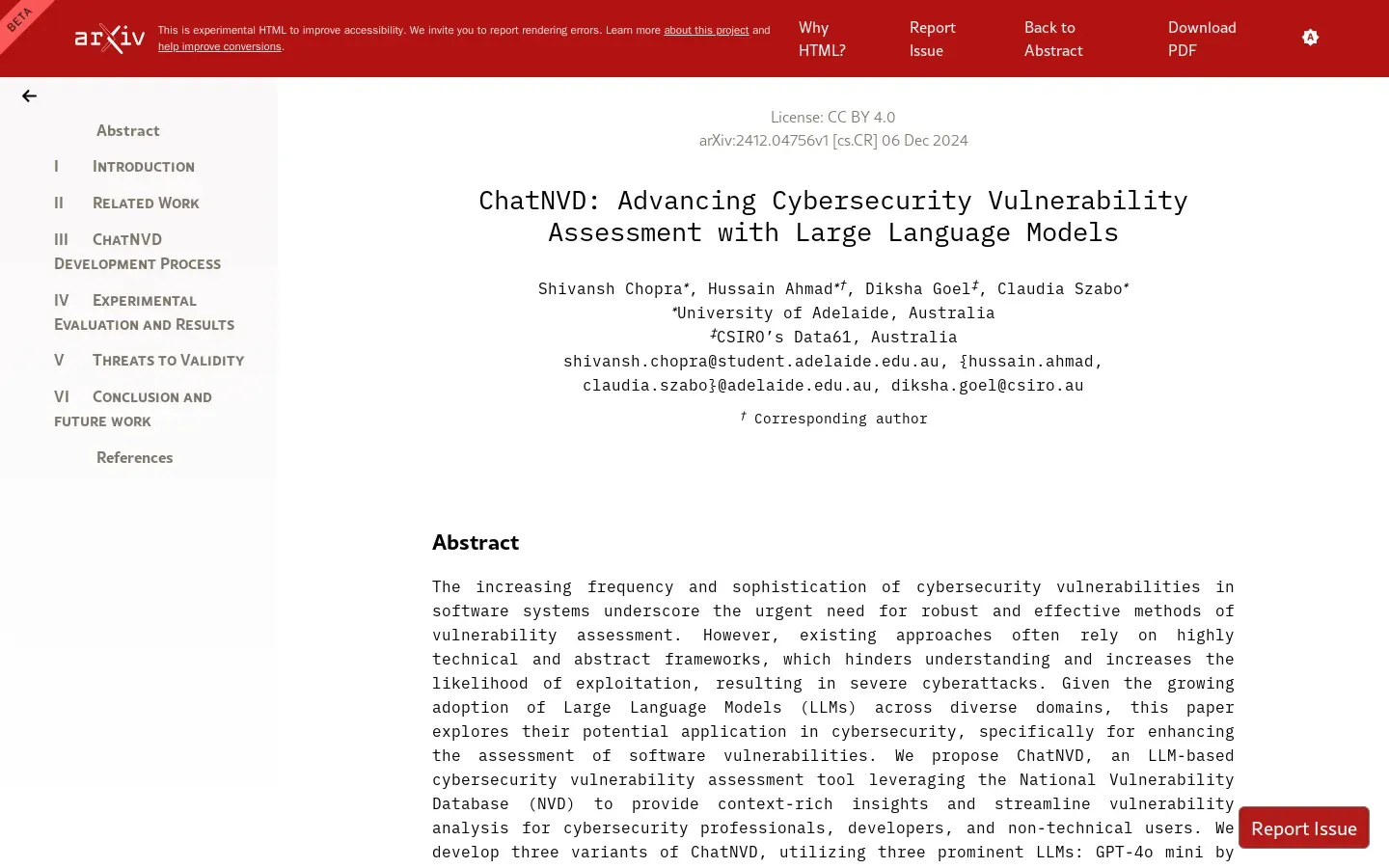
ChatNVD Tutorial Enhances Software Vulnerability Assessment Techniques
/ 5 min read
Quick take - A new tutorial has been introduced to improve software vulnerability assessment by utilizing advanced Large Language Models (LLMs) such as GPT-4o mini, Llama 3, and Gemini 1.5 Pro, aiming to enhance analysis accuracy and user accessibility in cybersecurity tools.
Fast Facts
- A new tutorial aims to enhance software vulnerability assessment using advanced Large Language Models (LLMs) like GPT-4o mini, Llama 3, and Gemini 1.5 Pro.
- The initiative focuses on improving analysis and interpretation of software vulnerabilities while providing a user-friendly interface and accessible APIs for diverse users.
- Key steps in developing the ChatNVD tool include data collection, model training, integration with existing tools, and user feedback for continuous improvement.
- Organizations are encouraged to train teams on LLM capabilities, implement feedback loops, and foster open communication to maximize the effectiveness of LLMs in cybersecurity.
- Users should be aware of common pitfalls, such as over-reliance on automated tools, false positives, and the importance of a holistic security strategy to effectively manage cybersecurity risks.
Enhancing Software Vulnerability Assessment Through Large Language Models
A new tutorial has emerged, aiming to revolutionize the understanding and assessment of software vulnerabilities by harnessing the power of advanced Large Language Models (LLMs). This initiative is centered around three prominent LLMs—GPT-4o mini, Llama 3, and Gemini 1.5 Pro—to bolster tools available for users seeking insights into software security.
Leveraging Advanced LLMs for Security
The tutorial is structured with two primary objectives. Firstly, it seeks to utilize the capabilities of LLMs to enhance the analysis and interpretation of software vulnerabilities. By employing cutting-edge models like GPT-4o mini, Llama 3, and Gemini 1.5 Pro, the initiative aims to deliver deeper insights and more precise assessments of potential security risks inherent in software applications.
Secondly, the tutorial underscores the importance of facilitating user interaction. To achieve this, a user-friendly interface and accessible APIs for ChatNVD have been implemented. This design choice ensures that a diverse range of users—from software developers to security analysts—can seamlessly interact with the system and retrieve vital information regarding software vulnerabilities without facing significant barriers.
Implications for Software Security
The implications of this tutorial are profound for the field of software security. By integrating advanced LLMs into the vulnerability assessment process, the tutorial not only aims to enhance the accuracy and efficiency of identifying software risks but also democratizes access to this critical information. As more individuals and organizations leverage these tools, the overall resilience of software systems against vulnerabilities is likely to improve, contributing to a more secure digital landscape.
The focus on user-friendly interfaces further suggests a growing recognition of the need for accessibility in cybersecurity tools. This makes it easier for a broader audience to engage with complex security concepts. In summary, this initiative represents a forward-thinking approach to tackling software vulnerabilities, combining cutting-edge technology with user-centric design to foster a more secure software environment.
Key Steps in Developing ChatNVD
The tutorial outlines four essential steps in developing ChatNVD, an LLM-based cybersecurity vulnerability assessment tool:
-
Data Collection: The first step involves gathering a comprehensive dataset that includes historical vulnerability data, threat intelligence reports, and relevant cybersecurity frameworks. This data serves as the foundation for training the LLM, ensuring it understands various vulnerabilities’ nuances and implications.
-
Model Training: Once data is collected, it undergoes preprocessing and cleaning before being fed into the model. Training requires careful tuning of parameters and selecting appropriate algorithms to enhance its ability to predict vulnerabilities accurately. Validation with test datasets ensures reliability.
-
Integration with Existing Tools: After training, integrating ChatNVD with existing cybersecurity tools and platforms is crucial. This allows for real-time vulnerability assessments and automated reporting, making it easier for professionals to identify and mitigate risks effectively.
-
User Feedback and Iteration: Implementing a feedback mechanism is vital for continuous improvement. Insights from users and performance analysis in real-world scenarios help refine the tool, making it more intuitive and effective over time.
Maximizing LLM Potential in Cybersecurity
Organizations should prioritize training their teams on these models’ capabilities and limitations, ensuring personnel can interpret generated insights effectively. Continuous monitoring and evaluation of LLM performance are crucial; feedback loops allow model refinement based on real-world application and emerging threats.
Moreover, fostering open communication about cybersecurity risks enhances LLM effectiveness. Encouraging cross-departmental dialogue provides a comprehensive understanding of potential vulnerabilities, which can then be addressed with greater precision.
Common Pitfalls in Using Automated Tools
When utilizing tools like ChatNVD for cybersecurity vulnerability assessment, users should be aware of common pitfalls:
-
Overreliance on Automation: Automated tools may not capture all security issues present in a system. Complement automated assessments with manual reviews and expert analysis.
-
False Positives: Automated tools can flag benign configurations as vulnerabilities. Verify findings and prioritize issues based on context rather than treating every flagged item as an immediate threat.
-
Keeping Tools Updated: Regular updates are necessary to maintain effectiveness amid evolving cybersecurity landscapes.
-
Holistic Assessments: Conduct vulnerability assessments as part of a comprehensive strategy rather than piecemeal efforts.
-
Continuous Learning: Engage with the cybersecurity community and participate in training to enhance overall security posture.
Essential Tools for Enhanced Vulnerability Assessment
Several crucial tools complement ChatNVD’s capabilities:
-
National Vulnerability Database (NVD): A comprehensive catalog aiding professionals in staying informed about threats.
-
ChatNVD: Utilizes advanced algorithms for accurate vulnerability identification.
-
Large Language Models (LLMs): Enhance capabilities through natural language processing.
-
TF-IDF (Term Frequency-Inverse Document Frequency): Prioritizes vulnerabilities based on frequency across sources.
These resources provide a robust framework for enhancing vulnerability assessments, ensuring organizations can proactively address potential threats in their cybersecurity strategies.



